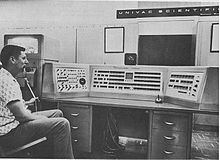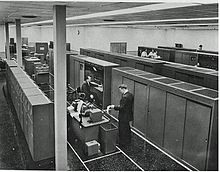Engineering Research Associates
Engineering Research Associates (1946–1952), also known by the abbreviation ERA , was a pioneer in the manufacture of mainframe computers . ERA later became known for its drum storage technology . In 1955, ERA was bought by Remington Rand and incorporated into the UNIVAC business unit . Many of the company's former employees later left Remington Rand to form Control Data Corporation .
Emergence
The ERA team was originally a group of scientists and engineers who primarily worked in the field of cryptography for the American Navy during World War II . After the war, the military's budgets were cut. Joseph Wenger , head of the Communications Supplementary Activity - Washington (CSAW) crypto group , was concerned that the individual employees would migrate to civil companies, and that the American Navy would lose its knowledge in the field of cryptography.
Wenger and two other associates, William C. Norris and Howard Engstrom , began looking for investors interested in helping a new computer company. Finally, they found the investor in the person of John Parker, an investment banker, the Chase Aircraft - Aircraft -Fabrik Northwest Aeronautical Corporation (NAC) in Saint Paul (Minnesota) led. The NAC was forced to close its factories after the war, as practically all orders were suspended at the end of the war. Parker knew nothing about the work of ERA employees and could not be informed because the work was confidential. After being visited by some senior naval officers , Parker felt that there was more to it and that he should get in as an investor. The ERA team moved into the NAC factory in 1946.
The first years
During the first few years the company took whatever work it could find. Nevertheless, the company only made a living from the manufacture of calculating machines for deciphering encrypted texts. Back then, the machines were specially built for decrypting a specific encryption technique. Over time, more and more drum stores were used to temporarily store the messages to be decrypted. In order to maintain secrecy, the entire factory site was classified as the base of the American Navy and was guarded 24 hours a day by the American military.
The Goldberg, Demon and ATLAS
One of the first machines, which was built in 1947, the Goldberg , used a self-made drum to which magnetic film was glued and which rotated at around 50 revolutions per minute. Over time, the storage system together with the punched tape readers continued to develop .
Next, the Demon was built, which was supposed to crack a Soviet encryption. When the Russians changed the encryption technology in 1949, the Demon computer was worthless. One of the engineers, James Pendergrass, was convinced that the only way to prevent such a situation from happening in the future was to design machines so that they could be reprogrammed. In 1947, ERA received an order from the American Navy to design a machine under the code name Task 13 , which was one of the first to be programmable in memory . The machine was delivered under the name ATLAS-I in 1950.
ERA then wanted to sell the machine commercially under the name ERA 1101 , where the number 1101 is the binary representation of the number 13. Even before the ATLAS machine was delivered, the American Navy ordered a new machine, the ATLAS-II , which, in contrast to the ATLAS-I, which still used drum storage, was to be based on Williams tube technology . Work on ATLAS-II began in 1950 and the machine was delivered to the NSA in 1953 (officially not yet existing at the time).
Takeover by Remington Rand
ERA tried to sell the commercial versions of the machines to other customers, but was quickly caught up with political problems. Washington, DC believed there was a conflict of interest as the company was eventually founded by former military personnel for their own profit. The dispute eventually ended in court and drained the company financially. In 1952, ERA was bought by Remington Rand .
After buying Eckert-Mauchly Computer Corporation, Remington Rand already had a business unit that manufactured computers. For a while, ERA was run as an independent business unit. ERA focused on scientific and military computers while Eckert-Mauchly focused on civil computers ( UNIVAC ). But when Remington Rand merged with Sperry Corporation in 1955 , the two business units were merged. Except for the drum storage technology, Sperry now focused on the Eckert-Mauchly computer. Some of the ERA employees were not happy about the situation and left Sperry under the leadership of Norris to found Control Data Corporation . Among them was a young engineer named Seymour Cray , who later founded Cray Research .
Sperry recognized the unfortunate situation and decided to combine the remaining ERA employees in a separate business unit, the Military Division . In this unit, they mainly constructed computers that were used in the military sector. Among other things, they designed one of the first command and control systems as well as rocket and satellite controls as well as fire control systems . The business unit later became known as the Aerospace Division .
credentials
- Erwin Tomash, Arnold A. Cohen: The Birth of an ERA. Engineering Research Associates, Inc. 1945-1955. In: Annals of the History of Computing. Volume 1, No. 2, 1979.
- David Lundstrom: A Few Good Men from Univac. MIT Press, 1987, ISBN 0-262-62075-8 .


